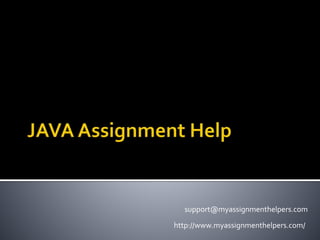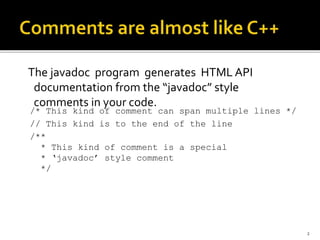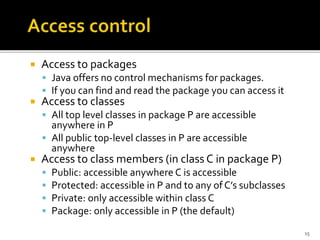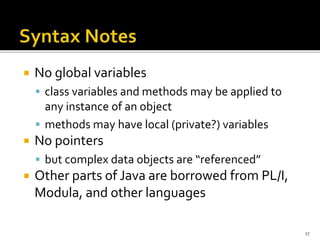The document provides an overview of Java programming concepts, including Javadoc comments, variable scope, object management, method structures, and class definitions. It emphasizes the importance of classes in Java, explaining constructors, method overloading, encapsulation, and access modifiers. Additionally, it contrasts Java's features with C/C++ and highlights concepts such as inheritance, abstraction, and the absence of pointers.




![ Person mary = new Person ( );
int myArray[ ] = new int[5];
int myArray[ ] = {1, 4, 9, 16, 25};
String languages [ ] = {"Prolog", "Java"};
Since arrays are objects they are allocated dynamically
Arrays, like all objects, are subject to garbage collection
when no more references remain
so fewer memory leaks
Java doesn’t have pointers!
5](https://image.slidesharecdn.com/javaassignmenthelp-151015115351-lva1-app6892/85/Java-assignment-help-5-320.jpg)




![/**
* This program computes the factorial of a number
*/
public class Factorial { // Define a class
public static void main(String[] args) { // The program starts here
int input = Integer.parseInt(args[0]); // Get the user's input
double result = factorial(input); // Compute the factorial
System.out.println(result); // Print out the result
} // The main() method ends here
public static double factorial(int x) { // This method computes x!
if (x < 0) // Check for bad input
return 0.0; // if bad, return 0
double fact = 1.0; // Begin with an initial value
while(x > 1) { // Loop until x equals 1
fact = fact * x; // multiply by x each time
x = x - 1; // and then decrement x
} // Jump back to the star of
loop
return fact; // Return the result
} // factorial() ends here
} // The class ends here
10
From Java in a Nutshell](https://image.slidesharecdn.com/javaassignmenthelp-151015115351-lva1-app6892/85/Java-assignment-help-10-320.jpg)






